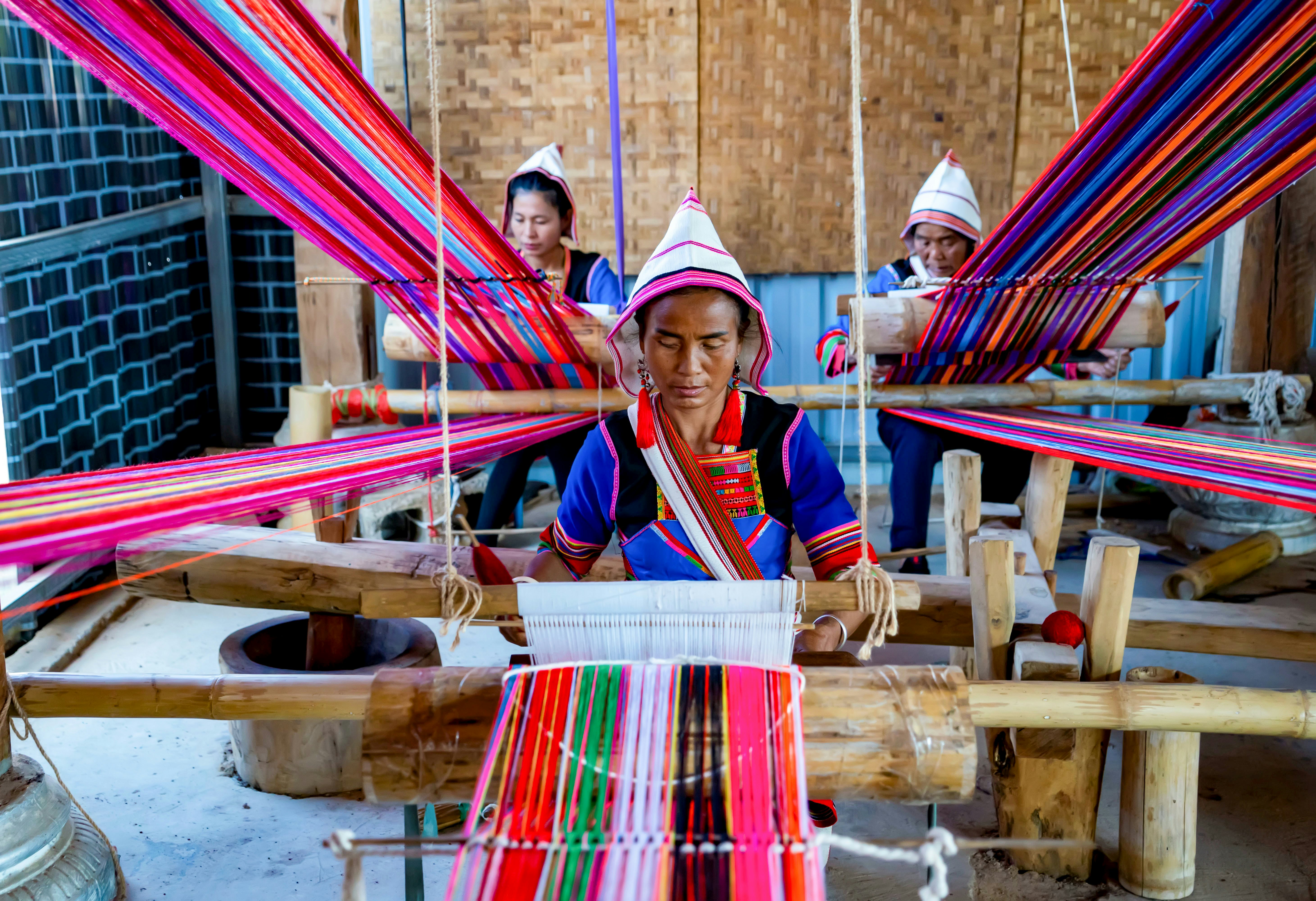

Crossing a narrow rope bridge in the National Tropical Rainforest Park in Mengla, Xishuangbanna © Feng Wei Photography / Getty Images
Whether winding through the overgrown foliage towards a quiet hamlet of the Bulang people – or climbing up through the tea plantations of the Hani – travelers interested in the intersection of culture and landscapes have long been drawn to this border region where China, Laos, and Myanmar (Burma) meet. Only in recent years has it truly hit mainstream consciousness.
Why go to Xishuangbanna now?
A boom in domestic tourism and infrastructure investment by the Chinese government has seen massive growth in Xishuangbanna (that's 'Banna for short) over the past decade, and with it increased connectivity to adventure experiences. While multi-day jungle treks are still very much possible (if a little harder to find than before), for many visitors the main outdoor draws are now easily-managed day trip experiences. Explore the vast rainforests of the region by daylight but return to a fancy new hotel or resort complex at night. For the moment both types of travel exist side-by-side, offering a plethora of options for nature lovers who make the trip out.
Best time to visit Xishuangbanna
The period from November to April in this tropical region is best for outdoor activities with lower temperatures and less rainfall. The September to October shoulder season can be pleasant if not perfect and with lower crowds in popular tourist destinations, but do try to avoid the intense heat and heavy rains from May to August.
Organizing a guided trek
Most local tour agencies can arrange treks of some variety, though you'll want to make your expectations clear in terms of both daily distance and acceptable ruggedness, especially for those that rarely deal with foreign tourists. Both the Mekong Cafe and the Forest Cafe in Jinghong can arrange treks and guides, while the Meimei Cafe doesn't offer booking services but has priceless old binders packed with information on where to go and how to get there.

Visit Xishuangbanna Tropical Botanical Garden in Menglun
China's largest botanical gardens mix exquisitely manicured pathways and wild tropical jungle in an easy day trip from Jinghong. Most visitors stick to the front section of the arboretum and with over 12,000 varieties of plants, set in distinct thematic zones, there's plenty to explore. But nature lovers with a sense of the offbeat will want to head to the back wilder section of the preserve. Here you'll find 250 hectares of true jungle with just a handful of pathways and signs to break the illusion of deep-forest immersion.
Stand eye-to-eye with monkeys in Sanchahe Nature Reserve
Sanchahe Nature Reserve offers an attractive jungle experience without having to work for it – a cable car whisks visitors from one end of the park to the other and elevated walking bridges on the return give visitors a decent chance of seeing wild birds and monkeys flying through the branches. The managed elephant experiences here are a turnoff for many visitors, but it's possible to visit the reserve while avoiding this section of the park.
Trek from Bulangshan to Menghun
This two-day trek that most independent visitors can navigate without trouble travels through bamboo forests and light jungle cover to explore less-remote areas between Menghai and Menghun. Overnighting in the Bulang village of Laomawo, it also gives hikers a chance to stay with a local family and see rural life firsthand. Meimei Cafe's website includes detailed directions on navigating this trek independently, or it (and most other local agencies) can arrange guides for you.
Swim in cascading Mandian Waterfalls
An easy, one-day outing from Jinghong, the series of cascading falls collectively known as the Mandian Waterfalls make an excellent trip both for the dense jungle hiking trail and the refreshing swim beneath a booming 20m (65.6ft) waterfall at the lowest and tallest of the fall's cascades. It's a sweaty bike-and-hike combo to get out from Jinghong or a quick van transfer and 2.5km (1.6-mile) hike up, but well worth it to experience raw nature so close to the capital's tourism bustle.

Zip over a jungle river
Adventure seekers looking for a bit of speed can zipline across a small ravine in the Xishuangbanna Primeval Forest Park. After the short but thrilling ride, head into Hani and Aini cultural villages next door or walk up to the Nine Dragon Falls to admire a little more of the area's natural splendor.
Head underground into Fairyland Cave at Mengyuan
Unusual in this region of Yunnan, the 1.4km (.9-mile) Fairyland Cave at Mengyuan leads visitors underground to a fantastical show of stalactites and stalagmites in bright neon hues that long-time China travelers will no doubt be familiar with. After visiting the cave itself, the surrounding jungle territory also warrants another hour or two of exploration.
Explore the Xishuangbanna jungle canopy
Unique in Xishuangbanna, the Sky Tree Scenic Area's aerial walkway takes travelers to the top of the rainforest on a 2.5km (1.6-mile) walk through the canopy 36m (118ft) above the forest floor. High among the jungle's giants, the call of birds and interplay of light and wind and water dripping from the foliage above gives an indelible perspective on an otherwise familiar habitat. Height-averse visitors can also explore land-based walks and river cruises on the same territory.

Walk to the Hani village of Aini
Among the most popular of easy day hikes near Jinghong, the half-day trip to Aini village is an accessible way to explore Pu'er tea plantations and experience local Hani culture within public transport distance via a connection in Menghai. Forest Cafe also runs an extended version of this that continues through banana plantations and rice paddies to a small Bulang village then through another tea-growing area back to public transport and Jinghong.
Meditate beneath the One Tree Forest
Dedication to meditation beneath a towering banyan tree has real religious significance in Buddhism, a callback to the Buddha himself, and Daluo village's towering banyan remains popular among visitors thanks to the association. A stunning natural beauty, with nearly 40 aerial root systems reaching back down towards the earth, a single glance makes it clear why this one massive tree could itself be considered a whole forest.
Hike from Mengsong to Yako and Bulangshan
This once-popular three-day trek still has some appeal, but many of the region's former favorite hikes are now increasingly encroached upon by development. From the eleven Akha cultural villages of Mengsong and Guangming, a trail through the Banna jungle winds to the village of Yako and the opportunity to spend a night in the home of a local family – eating local dishes and interacting directly with Akha hosts. Continuing on to Bulangshan, however, a very different trekking experience unfolds – occasional swathes of clear-cut forest and regular crossings of newly-constructed roads show the march of progress deeper and deeper into Xishuangbanna's jungles. Meimei Cafe's website includes detailed directions on navigating this trek independently, or it can arrange guides as can other local agencies.
Xishuangbanna is on our 2022 Best of Travel list. For more stories from some of the world’s most exciting destinations click here.
Safety recommendations and restrictions during a pandemic can change rapidly. Lonely Planet recommends that travelers always check with local authorities for up-to-date guidance before traveling during Covid-19.
You might also like:
The definitive guide to China's national parks
Alternative Yunnan: best towns and villages to beat the crowds
5 epic train journeys to take in China














